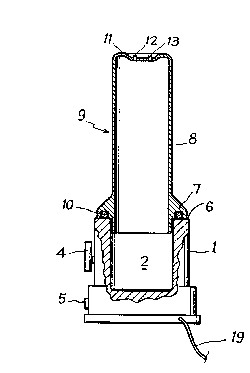Une partie des informations de ce site Web a été fournie par des sources externes. Le gouvernement du Canada n'assume aucune responsabilité concernant la précision, l'actualité ou la fiabilité des informations fournies par les sources externes. Les utilisateurs qui désirent employer cette information devraient consulter directement la source des informations. Le contenu fourni par les sources externes n'est pas assujetti aux exigences sur les langues officielles, la protection des renseignements personnels et l'accessibilité.
L'apparition de différences dans le texte et l'image des Revendications et de l'Abrégé dépend du moment auquel le document est publié. Les textes des Revendications et de l'Abrégé sont affichés :
| (12) Brevet: | (11) CA 1274567 |
|---|---|
| (21) Numéro de la demande: | 1274567 |
| (54) Titre français: | APPAREIL POUR RECHAUFFER ET STERILISER LES BIBERONS |
| (54) Titre anglais: | APPARATUS FOR WARMING UP AND STERILIZING BABIES' BOTTLES |
| Statut: | Périmé et au-delà du délai pour l’annulation |
| (51) Classification internationale des brevets (CIB): |
|
|---|---|
| (72) Inventeurs : |
|
| (73) Titulaires : |
|
| (71) Demandeurs : |
|
| (74) Agent: | HIRONS, BROWN & ORANGE |
| (74) Co-agent: | |
| (45) Délivré: | 1990-09-25 |
| (22) Date de dépôt: | 1986-06-10 |
| Licence disponible: | S.O. |
| Cédé au domaine public: | S.O. |
| (25) Langue des documents déposés: | Anglais |
| Traité de coopération en matière de brevets (PCT): | Non |
|---|
| (30) Données de priorité de la demande: | ||||||
|---|---|---|---|---|---|---|
|
ABSTRACT OF THE DISCLOSURE
This invention relates to an electrical apparatus
for warming up and sterilizing a baby's bottle,
comprising an open container or well provided with a
first electrical heating device controlled by a
thermostat adapted to warm up the bottle, said appara-
tus further comprising: a) a lid which is hermetically
fixed on the well by rapid-fixing means, so as to
form a closed compartment for sterilizing a bottle;
b) a second electrical heating device adapted to
enable a temperature higher than 100°C to be attained
in the closed compartment; c) a means for controlling
the second electrical heating device; d) at least
one valve on the lid; e) a means for interrupting
the second electrical heating device when steriliza-
tion is accomplished.
Note : Les revendications sont présentées dans la langue officielle dans laquelle elles ont été soumises.
Note : Les descriptions sont présentées dans la langue officielle dans laquelle elles ont été soumises.

2024-08-01 : Dans le cadre de la transition vers les Brevets de nouvelle génération (BNG), la base de données sur les brevets canadiens (BDBC) contient désormais un Historique d'événement plus détaillé, qui reproduit le Journal des événements de notre nouvelle solution interne.
Veuillez noter que les événements débutant par « Inactive : » se réfèrent à des événements qui ne sont plus utilisés dans notre nouvelle solution interne.
Pour une meilleure compréhension de l'état de la demande ou brevet qui figure sur cette page, la rubrique Mise en garde , et les descriptions de Brevet , Historique d'événement , Taxes périodiques et Historique des paiements devraient être consultées.
| Description | Date |
|---|---|
| Inactive : CIB de MCD | 2006-03-11 |
| Inactive : Demande ad hoc documentée | 1995-09-25 |
| Le délai pour l'annulation est expiré | 1995-03-25 |
| Lettre envoyée | 1994-09-26 |
| Accordé par délivrance | 1990-09-25 |
Il n'y a pas d'historique d'abandonnement
Les titulaires actuels et antérieures au dossier sont affichés en ordre alphabétique.
| Titulaires actuels au dossier |
|---|
| THERMOBABY S/A |
| Titulaires antérieures au dossier |
|---|
| ALAIN CAPPE |
| CLAUDE NABET |